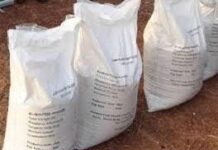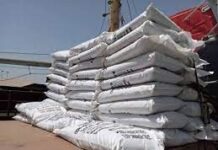with Abdoulie Dibba
This column is devoted to monitor and report on issues that are relating to food security in the  Gambia as well as the interventions of Government and Non-governmental Organizations.
Farmers’ Eye has been touring the country talking to the farming communities regarding their constraints and the way forward in ensuring food security in the Gambia. The farmers, however, have been repeatedly saying that there cannot be food security in the Gambia without increased productivity which is dependent on the availability of adequate farm implements, fertilizer and enough water for the
crops.
The Farmers also pointed out that the provision of small implements such as sine hoes and seeders to farmers on credit to facilitate ploughing will go a long way in ensuring food self sufficiency.
They noted that tractor ploughing is too expensive and most farmers could not afford the cost and for those who can afford it, its inadequacy cause long waiting queue which resulted to delay in planting.
In the last edition, Farmers’ Eye drew the attention of the readers on the causes of low agricultural productivity and yield in the Gambia with regard to the main crops produced which are groundnuts, maize, rice, sorghum, early and late millet.
It was stated in that edition that though over the years, crop production in the Gambia has been fluctuating, but where-ever it increased, the increase has been based on expansion of land under cultivation as the productivity of the land remains low across all the regions of the country.
It is apt to emphasized with all the emphasizes at one’s command that agricultural productivity and yields are low in the Gambia as a result of the following factors which are the inadequacy of mechanization levels, low level of fertilizer usage, limited access to improved seed, dependence on rain-fed agriculture among others.
Couple with the above factors, Food insecurity has been increasing in the Gambia due to unpredictable climate and declining rainfall and that the expected increases in the frequency and gravity of floods and droughts have raised concerns about the capacity of the Gambia to maintain its agricultural production without addressing the above.
In this edition, Farmers’ Eye will bring to the attention of the reader the intention of Government with regard to livestock, according to the ANR Policy. The subsequent editions, will be dealing with factors hindering the achievement of the Government’s set objectives.
According to the ANR Policy, the livestock sub-sector is a major potential source to contribute significantly to poverty reduction and growth of the sector in particular and the economy in general.
The sub sector the policy states, has an apparent comparative advantage in producing competitive beef products for the high value markets of the local Tourist Industry and for exports, and self reliant sufficient ruminant and poultry meat for household consumption and income from local sales and import substitution.
The value chains of the sub sector, especially production and processing offer great opportunities for increasing income and employment of rural populations where the resource is prevalent, and investment in agro-processing. The realization of these prospects will however depend largely on the level and extent of modernizing and commercializing the sector, with greater emphasis on production, marketing and processing, diversifying the production base for food security, and intensive sensitization of the grass roots institutions in the sector, business interests for investment, and strengthened delivery services to transfer knowledge and skills.
The Policy Objectives states the following:-
i). By the year 2015 sustainable production and productivity of livestock improved and meeting at least 75% of national demands in meat and meat products and by at least 25% of milk products over present levels;
ii). Policy advice and regulation, functional delivery services and essential inputs are available, affordable and accessible in every region, and contributing to measurable increase in production of livestock;
iii). Value chains (production, processing and marketing ) of the livestock sub sector are efficient, effective and linked directly to markets, producing competitive products and increasing incomes and employment;
iv). National policies coordinated and harmonised with regional and international Policies and Initiatives for increased economic integration of the Gambia into the sub region, and enhanced complementarities between the Gambia and other countries in the region;
v). Guidelines, measures and regulations enforced to ensure sustainable management of the country’s natural resource base (land and water resources and germ plasm).
We are in 2015 and what is the situation? Follow Farmers’ Eye.
]]>
Gambia as well as the interventions of Government and Non-governmental Organizations.
Farmers’ Eye has been touring the country talking to the farming communities regarding their constraints and the way forward in ensuring food security in the Gambia. The farmers, however, have been repeatedly saying that there cannot be food security in the Gambia without increased productivity which is dependent on the availability of adequate farm implements, fertilizer and enough water for the
crops.
The Farmers also pointed out that the provision of small implements such as sine hoes and seeders to farmers on credit to facilitate ploughing will go a long way in ensuring food self sufficiency.
They noted that tractor ploughing is too expensive and most farmers could not afford the cost and for those who can afford it, its inadequacy cause long waiting queue which resulted to delay in planting.
In the last edition, Farmers’ Eye drew the attention of the readers on the causes of low agricultural productivity and yield in the Gambia with regard to the main crops produced which are groundnuts, maize, rice, sorghum, early and late millet.
It was stated in that edition that though over the years, crop production in the Gambia has been fluctuating, but where-ever it increased, the increase has been based on expansion of land under cultivation as the productivity of the land remains low across all the regions of the country.
It is apt to emphasized with all the emphasizes at one’s command that agricultural productivity and yields are low in the Gambia as a result of the following factors which are the inadequacy of mechanization levels, low level of fertilizer usage, limited access to improved seed, dependence on rain-fed agriculture among others.
Couple with the above factors, Food insecurity has been increasing in the Gambia due to unpredictable climate and declining rainfall and that the expected increases in the frequency and gravity of floods and droughts have raised concerns about the capacity of the Gambia to maintain its agricultural production without addressing the above.
In this edition, Farmers’ Eye will bring to the attention of the reader the intention of Government with regard to livestock, according to the ANR Policy. The subsequent editions, will be dealing with factors hindering the achievement of the Government’s set objectives.
According to the ANR Policy, the livestock sub-sector is a major potential source to contribute significantly to poverty reduction and growth of the sector in particular and the economy in general.
The sub sector the policy states, has an apparent comparative advantage in producing competitive beef products for the high value markets of the local Tourist Industry and for exports, and self reliant sufficient ruminant and poultry meat for household consumption and income from local sales and import substitution.
The value chains of the sub sector, especially production and processing offer great opportunities for increasing income and employment of rural populations where the resource is prevalent, and investment in agro-processing. The realization of these prospects will however depend largely on the level and extent of modernizing and commercializing the sector, with greater emphasis on production, marketing and processing, diversifying the production base for food security, and intensive sensitization of the grass roots institutions in the sector, business interests for investment, and strengthened delivery services to transfer knowledge and skills.
The Policy Objectives states the following:-
i). By the year 2015 sustainable production and productivity of livestock improved and meeting at least 75% of national demands in meat and meat products and by at least 25% of milk products over present levels;
ii). Policy advice and regulation, functional delivery services and essential inputs are available, affordable and accessible in every region, and contributing to measurable increase in production of livestock;
iii). Value chains (production, processing and marketing ) of the livestock sub sector are efficient, effective and linked directly to markets, producing competitive products and increasing incomes and employment;
iv). National policies coordinated and harmonised with regional and international Policies and Initiatives for increased economic integration of the Gambia into the sub region, and enhanced complementarities between the Gambia and other countries in the region;
v). Guidelines, measures and regulations enforced to ensure sustainable management of the country’s natural resource base (land and water resources and germ plasm).
We are in 2015 and what is the situation? Follow Farmers’ Eye.
]]>
FOCUS ON THE AGRI PROGRAMS PART ELEVEN LINKING AGRICULTURE TO PROCESSING
Facebook Notice for EU!
You need to login to view and post FB Comments!




















